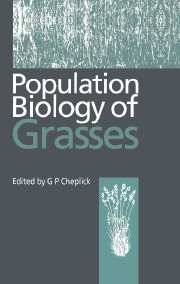Book contents
- Frontmatter
- Contents
- Contributors
- Preface
- Darwin revisited: approaches to the ecological study of grasses
- Part one Population variation and life history patterns
- Part two Ecological interactions
- 8 Plant–plant interactions in grasses and grasslands
- 9 Competition between grasses and woody plants
- 10 Fungal endophyte infection and the population dynamics of grasses
- 11 Arbuscular mycorrhizas and the population biology of grasses
- Part three Population biology of specific groups
- Index
11 - Arbuscular mycorrhizas and the population biology of grasses
Published online by Cambridge University Press: 14 September 2009
- Frontmatter
- Contents
- Contributors
- Preface
- Darwin revisited: approaches to the ecological study of grasses
- Part one Population variation and life history patterns
- Part two Ecological interactions
- 8 Plant–plant interactions in grasses and grasslands
- 9 Competition between grasses and woody plants
- 10 Fungal endophyte infection and the population dynamics of grasses
- 11 Arbuscular mycorrhizas and the population biology of grasses
- Part three Population biology of specific groups
- Index
Summary
Introduction
The majority of herbaceous plant roots growing in natural ecosystems are colonized by the arbuscular mycorrhizal (AM) fungi, otherwise known as the vesicular-arbuscular mycorrhizal (VAM) fungi (Trappe, 1987). These are relatively primitive fungi belonging to six genera (Acaulospora, Entrophospora, Gigaspora, Glomus, Sclerocystis and Scutellospora) in the order Glomales and class Zygomycetes (Morton & Benny, 1990). Despite their simplicity, these fungi have become the main mutualistic organisms associated with grasses, with the possible exception of clavicipitaceous leaf endophytic fungi (see Clay, this volume). AM fungi typically enter plant roots via root hairs from either chlamydospores in the root zone or more commonly from other colonized roots (Read, Koucheki & Hodgson, 1976) and form comparatively broad and typically non-septate hyphae within roots. These give rise to finely branched haustoria, termed arbuscules, which have a high surface area in contact with the plant plasmalemma and which are usually considered to be the point of nutrient exchange between the fungus and its host (Smith & Gianinazzi-Pearson, 1988). Large terminal or intercalary structures termed vesicles develop at later stages in the colonization of roots (Vietti & van Staden, 1990). These contain fatty acids, lipids and sterols (Jabaji-Hare, Deschene & Kendrick, 1984) and are usually thought to be storage organs.
Since AM fungi are heterotrophic, they rely upon their plant host for up to 20% of carbon fixed in leaves (Wang et al., 1989) in what Harley (1975) referred to as ‘a direct short-circuiting of photosynthesis’. In return, the fungus generally confers benefits on its plant host, most notably in the acquisition of phosphorus (P), a highly immobile element in soil which is therefore frequently limiting to plant growth.
- Type
- Chapter
- Information
- Population Biology of Grasses , pp. 286 - 310Publisher: Cambridge University PressPrint publication year: 1998
- 10
- Cited by



